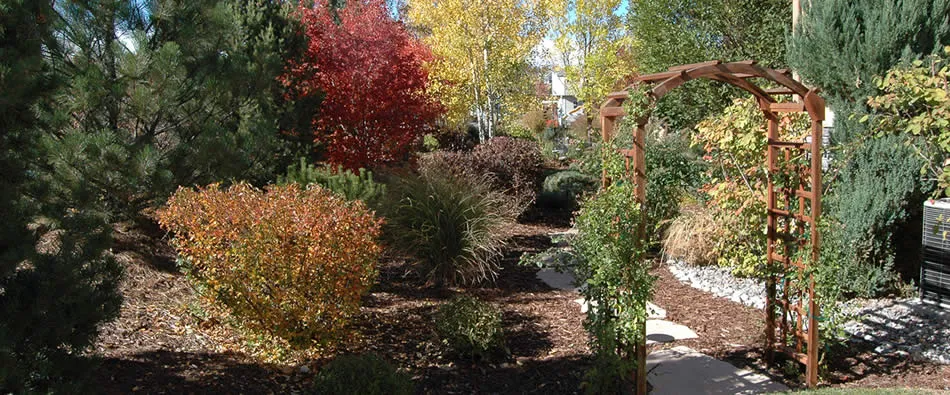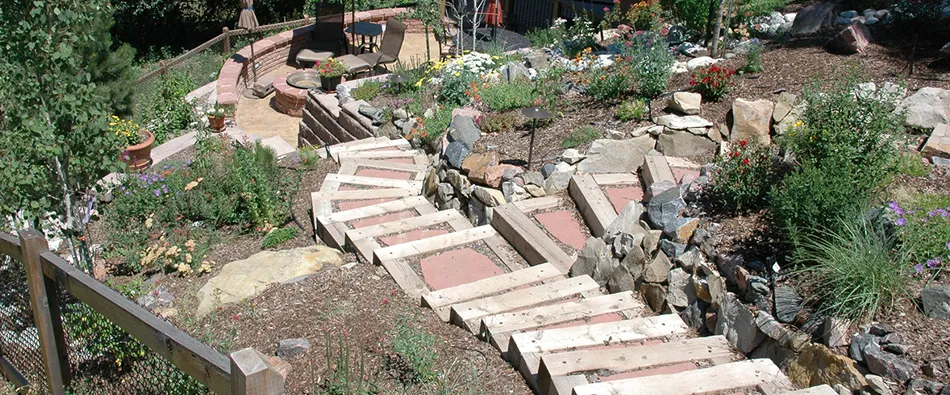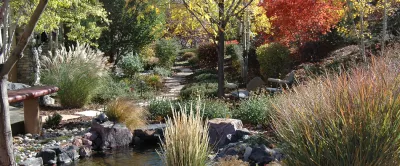The perfect lawn has met its match. Homeowners, in the ever-expanding quest to save money—and water—are trading in clipped hedges and putting-green turf for landscaping that is much closer to what might have grown there in the first place.
Denise McConnell got tired of the lawn that surrounded her Las Vegas home. The grass needed watering almost every day, mowing every week and a seasonal schedule of fertilizer and weed-control applications. To top it all off, it looked dull. "It was pretty nondescript," the 62-year-old accountant says. "And my water bill was averaging about $100 a month."
Inspired by the gardens she saw on a trip to Italy's Tuscan countryside, Ms. McConnell worked hard and gradually transformed her yard into an oasis of heat-tolerant and water-efficient plants. Today, she is surrounded by beds of flowering perennials, herbs and fragrant vines. Her garden offers maximum privacy, and her monthly water bill? Cut in half, to about $50.
Garden-design strategies that encourage minimal watering, called "xeriscaping"—based on the Greek word for 'dry'—first emerged in the West, where water resources are thin. Employees of Denver's water department are widely believed to have coined the term in the early 1980s—and now it is spreading in other regions among conservation-minded homeowners who want to grow beautiful gardens.
Many xeric principles are simply common sense: Choose native plants rather than exotics, which can sometimes need lots of extra hosing. Group plants according to water need to avoid unnecessary drenching. And use mulches—such as pine shavings or gravel—to minimize water evaporation and keep weeds at bay.
Jenny Rose Carey took a trip to the south of France several years ago and was struck by the plentiful lavender growing in poor, dry soil on the roadsides. It dawned on her that her efforts to add nutrient-rich compost to her garden beds weren't necessarily helping the plants. In fact, she suspected she might have better success with some if they grew in leaner conditions. Back home on her four acres in Ambler, Pa., Ms. Carey later that year began work on what she calls her "dry garden."
Now, soil slightly hilled around a spiraling path of stone elevates flower beds to help encourage drainage—a critical element in xeric garden design, because it keeps roots of dry-loving plants from sitting in water. River gravel serves as a mulch and wicks dampness away from the crown of plants. Plantings are in drifts of color: A block of orange California poppies (Eschscholzia californica) are followed by yellow-flowering ice plants (Delosperma nubigenum), followed by a drift of rose campions (Lychnis coronaria).
"I wanted it to look more like a cottage garden than feel like Arizona," says Ms. Carey. These days, with rainfall scarce, she says her garden is "rather neglected"—and looking its best.
Municipalities and water utilities want people to go xeric, offering "cash-for-grass" incentives to homeowners who replace lawns with low-water-use gardens. Not to long ago the city of Austin, Texas, offered a "landscape conversion incentive" that pays homeowners $20 to $30 per 100 square feet of garden that is converted using plants from an approved list. The Arizona town of Peoria expanded its "xeriscape conversion" program in 2009, offering homeowners and businesses as much as $715—up from $550—to get rid of lawns.
Water customers in Cary, N.C., may be eligible for $500 if they replace at least 1,000 square feet of turf with either a more heat-tolerant variety of grass or a "natural area" that might include a patio or a garden filled with drought-tolerant plants. Utilities find paying people to alter landscaping is "cost effective over the long run," says Doug Bennett, conservation manager with the Southern Nevada Water Authority, which pays an average of $1,300 per homeowner for a xeriscape conversion. That often proves less expensive than finding more resources, he says, whether by purchasing water rights or building pipelines.
Water savings from xeriscaping can be immense. On average, landscape watering accounts for between 40% and 70% of residential water use, according to the Water Research Foundation, of Denver. A 2005 report by the Southern Nevada Water Authority on the five-year landscape-water use of more than 700 homeowners found those who converted to xeriscapes from grass turf reduced their annual household water use by 30% on average.
But many gardeners are deeply attached to their green lawns. And when people move from one region of the country to another, they often bring along their old notions of what a residential landscape should look like. "For a good third or more of this country, green isn't part of the natural plant community," says Lauren Springer, a garden designer who works in Texas and Colorado. "The idea that green means healthy and growing and that you're a good gardener is just wrong," she adds.
The push to replace lawns often rubs against community homeowner associations favoring tidy uniformity. Rules may require property owners to maintain a certain amount of well-groomed lawn. Homeowners in Primrose Pointe, an Albuquerque, N.M., development, are required to maintain "irrigated turf" on at least half of their front yards, says Kimberly Corcoran, vice president for Canyon Gate Real Estate Services LLC, which manages the homeowners' association.
That rule may run up against a Bernalillo County ordinance, slated to take effect in October, saying that "restrictive covenants which require turf grass ... or otherwise restrict, limit or increase the cost for xeriscaping ... shall be considered contrary to public policy." Ms. Corcoran says her organization will "review what the rule is and be in compliance with that."
Four yeas ago, Nick and Maggie Camperlengo, homeowners in Hurst, Texas, decided they were done fertilizing, watering, cutting and edging their lawn. "It was an uphill battle against Mother Nature," says Ms. Camperlengo. "I said, 'Let's go a little more natural in what's supposed to be here.' " That summer, they started replacing their lawn with perennials and wildflowers such as yarrows, salvias, catmints and coneflowers. Ms. Camperlengo applied for and received a "certified wildlife habitat" designation from the National Wildlife Federation, and she put up a sign saying her garden provides food, water and shelter for birds and other pollinators.
City Hall was unimpressed. Ms. Camperlengo got a letter from the neighborhood-services office calling her property "a nuisance." "Your landscaping needs to be brought up to the standards of the neighborhood in which you choose to reside in," it said. Since then, an inspector visits once or twice a year—usually after a neighbor complains. The Camperlengos have received violations—one called the yard "offensive to neighborhood"—but haven't been fined, Ms. Camperlengo says. The most recent visit was in spring, "when everything was in bloom and really pretty," she adds, "so I don't understand."
The lack of understanding is mutual, some neighbors say. Yet Mark Seymour, who lives across the street, says he likes the yard's "earthy tone." "Everyone takes their lawn dead seriously around here," he says. "I like the way theirs looks because it's very natural."
Ashleigh Whiteman, communications manager for the City of Hurst, says creativity in landscaping "is not something we're against by any means." She says she has seen the Camperlengos' garden and thought the complaining neighbors "had a legitimate point."
------------------------------------------------------------
Denver, Colorado






